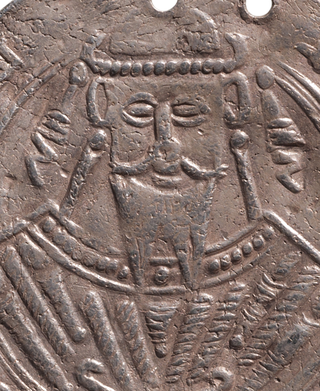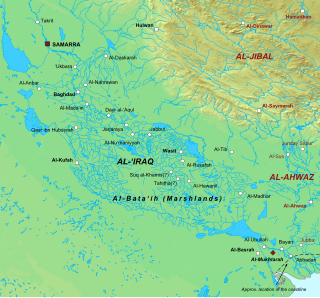Related Research Articles

Abū al-ʿAbbās Abd Allāh ibn Hārūn al-Maʾmūn, better known by his regnal name al-Ma'mun, was the seventh Abbasid caliph, who reigned from 813 until his death in 833. He succeeded his half-brother al-Amin after a civil war, during which the cohesion of the Abbasid Caliphate was weakened by rebellions and the rise of local strongmen; much of his domestic reign was consumed in pacification campaigns. Well educated and with a considerable interest in scholarship, al-Ma'mun promoted the Translation Movement, the flowering of learning and the sciences in Baghdad, and the publishing of al-Khwarizmi's book now known as "Algebra". He is also known for supporting the doctrine of Mu'tazilism and for imprisoning Imam Ahmad ibn Hanbal, the rise of religious persecution (mihna), and for the resumption of large-scale warfare with the Byzantine Empire.

Abū Isḥāq Muḥammad ibn Hārūn al-Rashīd, better known by his regnal name al-Muʿtaṣim biʾllāh, was the eighth Abbasid caliph, ruling from 833 until his death in 842. A younger son of Caliph Harun al-Rashid, he rose to prominence through his formation of a private army composed predominantly of Turkic slave-soldiers. This proved useful to his half-brother, Caliph al-Ma'mun, who employed al-Mu'tasim and his Turkish guard to counterbalance other powerful interest groups in the state, as well as employing them in campaigns against rebels and the Byzantine Empire. When al-Ma'mun died unexpectedly on campaign in August 833, al-Mu'tasim was thus well placed to succeed him, overriding the claims of al-Ma'mun's son al-Abbas.

Abū Jaʿfar Hārūn ibn Muḥammad al-Wathiq bi'Llah, commonly known by his regnal name al-Wathiq bi'Llah, was an Abbasid caliph who reigned from 842 until his death in 847.

Ja'far ibn Muḥammad ibn Hārūn al-Mutawakkil ʿalā Allāh ; March 822 – 11 December 861, commonly known by his regnal name al-Mutawwakil ala Allah, was the tenth Abbasid caliph, ruling from 847 until his assassination in 861. He succeeded his brother, al-Wathiq, and is known for expanding the empire to its maximum extent. He was deeply religious, and is remembered for discarding the Muʿtazila, ending the Mihna, and releasing Ahmad ibn Hanbal. He is also known for his tough rule, especially with respect to non-Muslim subjects.

Wasit was an early Islamic city in Iraq. It was founded in the 8th century by the Umayyad viceroy of Iraq, al-Hajjaj ibn Yusuf, to serve as the region's seat and as the garrison of the Syrian troops who enforced Umayyad rule there. It was situated between the two traditional administrative centers and garrisons of Iraq, Kufa and Basra, hence its name Wasit. The city was abandoned centuries later and its ruins are located in the eponymous Wasit Governorate, southeast of Kut in southeastern Iraq.
Abu Ja'far Ashinas was a general of the Abbasid caliph Al-Mu'tasim. One of the earliest and most prominent members of al-Mu'tasim's Turkic guard, he rose to become one of the leading figures of the empire under al-Mu'tasim, serving as a commander in the Amorium campaign, and playing a leading role in the purge of the old Abbasid elites that followed. He was also governor of Egypt from 834, as well as of the Levant and Upper Mesopotamia from 838 on, although in practice he appointed deputies to govern in his stead. Under al-Mu'tasim's successor al-Wathiq, his powers were extended further into a virtual viceroyalty over all western provinces of the caliphate.
Sind was an administrative division of the Umayyad Caliphate and later of the Abbasid Caliphate in post-classical India, from around 711 CE with the Umayyad conquest of Sindh by the Arab military commander Muhammad ibn al-Qasim, to around 854 CE with the emergence of the independent dynasties of the Habbarid Emirate in Sindh proper and the Emirate of Multan in Punjab. The "Governor of Sind" was an official who administered the caliphal province over what are now Sindh, southern Punjab and Makran (Balochistan) in Pakistan.
The Faraghina were a regiment in the regular army of the Abbasid Caliphate which was active during the ninth century A.D. Consisting of troops who originated from the region of Farghana in Transoxiana, the Faraghina participated in several military campaigns and played a significant role in the politics of the central government, especially during the Anarchy at Samarra.
The Ushrusaniyya were a regiment in the regular army of the Abbasid Caliphate. Formed in the early ninth century A.D., the unit consisted of soldiers who were originally from the region of Ushrusana in Transoxiana. The Ushrusaniyya initially served under the prominent general al-Afshin, but they remained active after his downfall, and are frequently mentioned during the period known as the Anarchy at Samarra.
Ishaq ibn Yahya ibn Mu'adh was a ninth-century provincial governor for the Abbasid Caliphate, serving as governor of Damascus and Egypt.
Isa ibn Yazid al-Juludi was a ninth century military commander for the Abbasid Caliphate. He twice served as governor of Egypt, from 827 to 829 and again from 829 to 830.
Abu al-Husayn Ishaq ibn Ibrahim was a ninth-century official in the service of the Abbasid Caliphate. A member of the Mus'abid family, he was related to the Tahirid governors of Khurasan, and was himself a prominent enforcer of caliphal policy during the reigns of al-Ma'mun, al-Mu'tasim, al-Wathiq, and al-Mutawakkil.
Abu Muhammad Yahya ibn Aktham was a ninth century Arab Islamic jurist. He twice served as the chief judge of the Abbasid Caliphate, from ca. 825 to 833 and 851 to 854.
Abu 'Abdallah Ahmad ibn Abi Du'ad al-Iyadi was an Islamic religious judge (qadi) of the mid-ninth century. A proponent of Mu'tazilism, he was appointed as chief judge of the Abbasid Caliphate in 833, and became highly influential during the caliphates of al-Mu'tasim and al-Wathiq. During his tenure as chief judge he sought to maintain Mu'tazilism as the official ideology of the state, and he played a leading role in prosecuting the Inquisition (mihnah) to ensure compliance with Mu'tazilite doctrines among officials and scholars. In 848 Ibn Abi Du'ad suffered a stroke and transferred his position to his son Muhammad, but his family's influence declined during the caliphate of al-Mutawakkil, who gradually abandoned Mu'tazilism and put an end to the mihnah.
Muḥammad ibn Muḥammad ibn Hārūn was an Abbasid prince, the son of Caliph al-Mu'tasim. He was a contemporary of the caliph al-Wathiq and al-Mutawakkil. His son Ahmad became the twelfth Abbasid caliph as al-Musta'in. Muhammad was the first prince in Abbasid history whose son became a caliph, no other Abbasid prince before him had this prestige.
Muhammad bin Uthman was a rebel leader who played a key role in the Zutt Rebellion, which took place in Iraq in the early 9th century CE. He was born into a family of the Zutt tribe who had settled in the region around Basra, and he rose to prominence as a military commander and political figure during the reign of Caliph al-Ma'mun.

Zutt Rebellion was a rebellion by the Zutt (Jats) Who were inhabitants of lower Indus Valley (Pakistan), between 810 and 835 in Iraq during the reign of al-Ma'mun and continued to the era of al-Mu'tasim.
Zuṭṭ is an Arabicised form of Jat. Originally inhabitants of lower Indus Valley (Pakistan), Jats were present in Mesopotamia from the 5th century AD since the times of the Sasanian Empire, although their main migration occurred after the establishment of Umayyad Caliphate. They were one of the prominent ethnic groups in lower Iraq during the Islamic Golden Age, supplying mercenary soldiers to the Muslim states. Their mention fades from Arab chronicles after the 11th century.
The Capture of Basra was a significant event during the Zutt Rebellion, in which the Zutts seized control of the city and ruled it independently. The rebellion stemmed from their dominance over waterways and canals, allowing them to exert control over vital resources and trade routes in the region.
References
- ↑ Ṭabarī (1951). The Reign of Al-Muʻtasim (833-842). American Oriental Society. p. 5.
- ↑ Ṭabarī (1951). The Reign of Al-Muʻtasim (833-842). American Oriental Society. p. 5.
- ↑ al-Baladhuri, Ahmad b. Yahya (2022). History of the Arab Invasions: The Conquest of the Lands. I.B. Tauris. p. 185. ISBN 9780755637416.
Zutt, who had taken over the Marshes between Wāsīt and Basra, to Ayn Zarba and they were made use of there.
- ↑ E.J. van Donzel (1994). Islamic Desk Reference: Compiled from The Encyclopaedia of Islam. Brill. ISBN 9789004505056.
Zutt, who had settled in the marshes between Wasit and Basra in great numbers, rose in rebellion during the reign of the Abbasid Caliph al-Ma'mun, but submitted in 834 on condition that their lives and property were spared.
- ↑ al-Baladhuri (2022). History of the Arab Invasions: The Conquest of the Lands. ISBN 9780755637416.
- ↑ Ṭabarī (1951). The Reign of Al-Muʻtasim (833-842). American Oriental Society. p. 5.
Wasit he pitched his camp with five thousand foot soldiers in a village ... Zutt used to go back and forth and thus he surrounded them on all sides ... Zutt for fifteen days and captured a great many more.
- ↑ Aḥmad ibn Yaḥyā al-Balādhurī (1916). The Origins of the Islamic State. University of Oxford. Modern History Faculty Library. p. 264.
- ↑ Redhouse, Sir James William (1884). كتاب معانئ لهجه: A Turkish and English Lexicon : Shewing in English the Significations of the Turkish Terms. American Presbyterian Mission Press. p. 1009.
- ↑ Hamilton Alexander Rosskeen Gibb (2001). The Encyclopaedia of Islam. Vol. 11, Parts 181–182. Brill. p. 168.